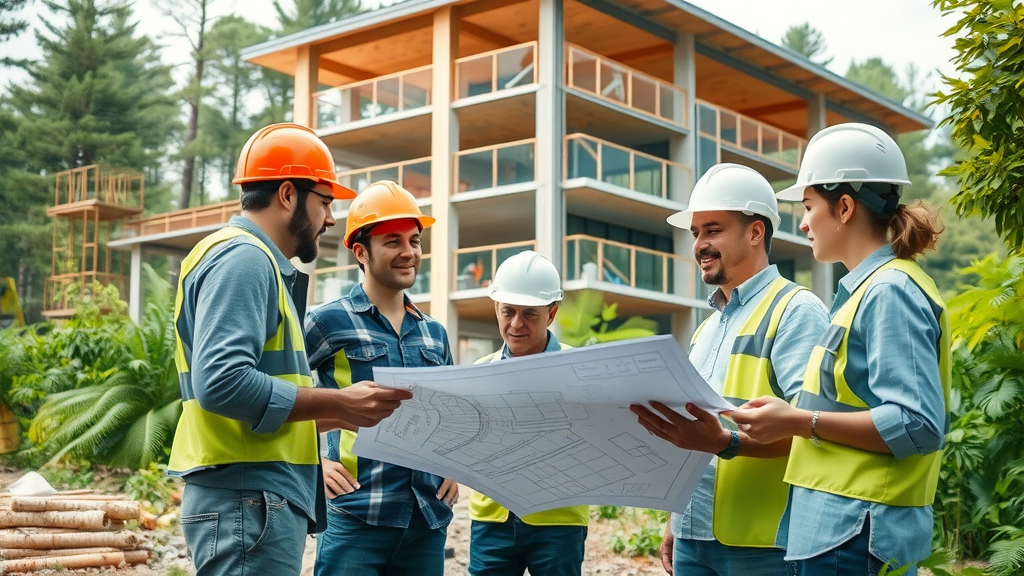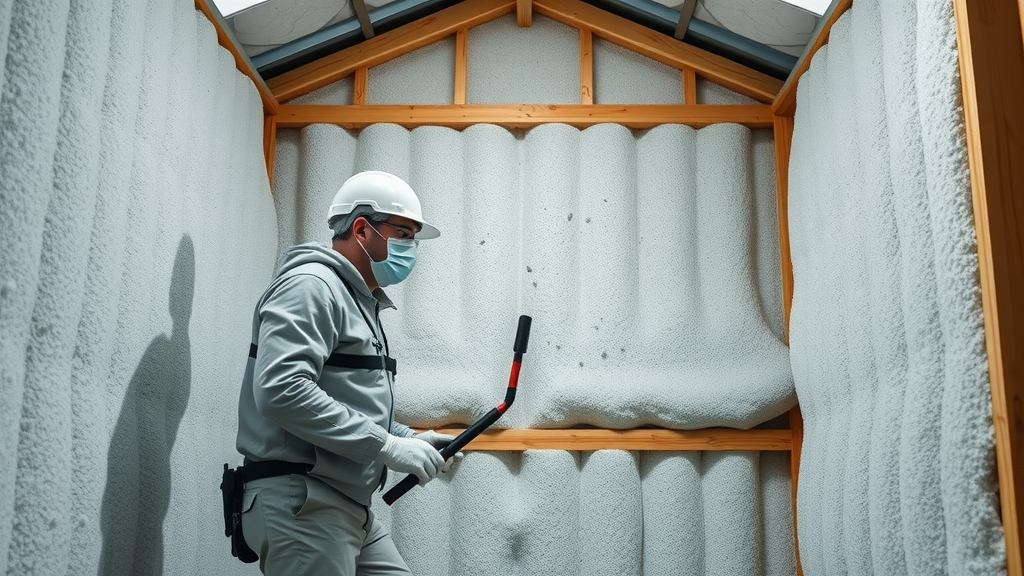Did you know? The construction industry alone accounts for nearly 40% of global carbon emissions. By choosing eco-friendly materials for your next project, you can play a key role in reducing this massive environmental footprint and building a more sustainable world. In this article, we’ll unveil the most innovative green building materials, compare them to traditional options, and show you step-by-step how these choices can transform not just your project, but the future of construction.
Unlocking the Potential: Why Eco-Friendly Materials are the Future of Sustainable Building
"Did you know that the construction industry is responsible for nearly 40% of global carbon emissions? Switching to eco-friendly materials can dramatically reduce this environmental footprint."
- The benefits of eco-friendly materials
- Top eco-friendly materials on the market
- How eco-friendly materials compare to traditional building materials
- How to integrate sustainable materials into your projects
As the urgency to address climate change intensifies, eco-friendly materials are emerging as the foundation of modern sustainable building. These materials are not just buzzwords in the green building movement—they offer tangible benefits like reduced carbon footprint, lower gas emissions, and improved energy efficiency. Unlike traditional building materials that often rely on depleting natural resources and generate significant waste during the manufacturing process, sustainable materials focus on renewal, reuse, and minimizing overall environmental impact. Their role is pivotal, whether you’re designing an ultra-efficient office or a cozy, environmentally friendly home. By making informed choices now, you contribute to healthier communities and protect valuable resources for generations to come.
But what exactly qualifies as an eco-friendly material? Any product engineered or harvested with the least possible impact—like recycled steel, natural fibre insulation, or materials sourced from rapidly renewing plants. Adoption of these materials is quickly becoming a defining trend in the construction industry, shaping everything from supply chains to finished project outcomes. Embracing them is not just a gesture towards the planet—it’s a strategic move towards modern, resilient, and future-ready building.

Top 15 Eco-Friendly Materials Revolutionizing Green Building
When it comes to transforming your project into an environmentally friendly success, the right materials make all the difference. Here’s a look at the most compelling eco-friendly materials on the market—each is setting new standards for performance, durability, and sustainability. These disruptors address every part of the building material lifecycle, from sourcing to end-of-use disposal, helping you achieve a low carbon footprint with every square foot built. Let’s dive into the top choices and why they matter for green buildings:
| Eco-Friendly Material | Type | Application | Eco Credentials |
|---|---|---|---|
| Bamboo | Natural fibre | Flooring, beams | Rapidly renewable |
| Recycled steel | Metal | Framing, infrastructure | Reduces mining |
| Sheep’s wool | Natural fibre | Insulation | Biodegradable |
| Hempcrete | Composite | Walls, insulation | Low CO2 footprint |
| Reclaimed wood | Wood | Flooring, wall panels | Resource efficiency |
| Cork | Natural resource | Flooring, insulation | Renewable, harvested without harm |
| Ferrock | Composite | Concrete alternative | Traps CO2 |
| Straw bale | Natural fibre | Wall construction | Superior insulation |
| Recycled plastic | Composite | Multiple uses | Diverts plastic from landfill |
| Rammed earth | Soil-based material | Walls | Minimal processing |
| Mycelium | Natural fibre | Insulation, tiles | Compostable |
| Low-VOC paints | Finishing | Walls, surfaces | Healthier indoor air |
| Eco-friendly brick | Brick | Walls, paving | Reduced emissions |
| Linoleum | Natural resource | Flooring | Made from flaxseed oil |
| Cellulose insulation | Recycled paper | Insulation | High recycled content |
1. Bamboo – A Rapidly Renewable Building Material
- Grows quickly
- Excellent strength-to-weight ratio
- Sustainable material choice
Bamboo is one of the most promising eco-friendly materials available today. Classified as a natural fibre, it boasts an impressive growth rate—maturing in just three to five years compared to the decades needed for most hardwoods. This remarkable capability makes it a premier renewable resource in the world of sustainable building materials. Its lightweight yet strong structure means bamboo can replace steel in certain structural applications and is an ideal building material for flooring, beams, and even decorative finishes. Moreover, its cultivation requires minimal energy consumption, fertilizer, or water, which further reduces its environmental impact. When you opt for bamboo, you’re making a clear statement in favor of friendly building and future-focused project design. Consider using bamboo in both modern and traditional green building projects to maximize sustainability without sacrificing style or durability.

2. Recycled Steel – Durable and Sustainable Construction Choice
- Utilizes existing materials
- Reduces mining impact
- Sustainable materials for large structures
Recycled steel has become a go-to material for builders seeking sustainable, robust solutions, particularly for larger infrastructures. By recycling steel rather than producing it from raw ore, the construction industry significantly slashes greenhouse gas emissions and the energy required in the manufacturing process. This not only preserves precious natural resources but also diverts waste from landfills, closing the loop in the building supply chain. Structures built with recycled steel demonstrate long-lasting durability and impressive resistance to fire and pests, addressing both safety and eco-friendliness. By choosing recycled steel for your next project, you directly contribute to reducing mining, conserving energy, and supporting a robust market for recycled materials within the construction industry. This approach aligns perfectly with the future of sustainable architecture and resilient design.
3. Sheep’s Wool – Natural Fibre Insulation
- Natural fibre insulation
- Regulates indoor humidity
- Fully biodegradable
Unmatched in its simplicity and effectiveness, sheep’s wool is a friendly building material with renewed popularity among green builders. As a natural fibre insulation, wool easily competes with synthetic options, providing superb thermal and acoustic insulation. but unlike synthetic insulators, sheep’s wool can absorb and release moisture without losing its insulating properties, naturally regulating indoor humidity. When it reaches the end of its life cycle, it decomposes harmlessly, returning nutrients to the earth without adding to landfills or polluting soil. With sheep’s wool, you get a sustainable material that champions health, comfort, and circular design for eco-friendly homes and commercial spaces alike.
4. Hempcrete – Eco-Friendly Materials for Green Building
- Lightweight composite
- Excellent insulation
- Carbon negative production
Hempcrete is a modern composite building material that’s rapidly gaining traction in the field of sustainable construction. Made primarily from the woody core of the industrial hemp plant mixed with a lime-based binder, hempcrete is both lightweight and strong. Its production process actually removes more CO2 from the atmosphere than it emits, making it a carbon negative material. Highly insulating and entirely biodegradable, hempcrete is ideal for non-loadbearing walls and retrofit applications. As more builders look for eco-friendly materials that minimize environmental impact, hempcrete leads the pack with its health, performance, and planet-friendly credentials.
5. Reclaimed Wood – Resource-Saving Friendly Building Material
- Reduces demand for new lumber
- Adds character and warmth
- Supports friendly building practices
Give new life to old materials with reclaimed wood, a beloved staple in eco-friendly building projects. By repurposing wood beams, floors, and panels from older structures, you minimize the need for fresh logging—a major win for forest conservation and resource efficiency. Not only does reclaimed wood reduce landfill waste, but it also lends unique character and richness to contemporary builds thanks to its distinctive grain, patina, and history. Its environmental impact is remarkably less than freshly milled lumber, making it a top choice for anyone serious about sustainable materials. Choosing reclaimed wood is a statement of creativity and commitment to eco-friendly building.

6. Cork – Renewable and Friendly Building Material
- Harvested sustainably
- Exceptional sound insulation
- Hypoallergenic
Harvested without cutting down trees, cork remains one of the world’s most sustainable materials for flooring and insulation. The bark is peeled from cork oak trees without harming the plant, allowing it to regrow and be re-harvested every several years. As an eco-friendly material, cork is not only a renewable resource but also offers significant acoustic and thermal insulation benefits. It resists mold, mildew, and pests, making it a healthy choice for allergen-sensitive projects. This friendly building material is at home in schools, offices, and green homes, ensuring comfort, style, and environmental stewardship with every step you take.
7. Ferrock – Innovative Sustainable Material for Construction
- Concrete alternative
- Traps CO2 during curing
- Increases durability
A new standout in the world of green building, Ferrock is an innovative composite that offers a virtually carbon-neutral concrete alternative. Made from recycled steel dust and other industrial byproducts, Ferrock not only diverts raw material waste but also sequesters carbon dioxide as it sets, actively reducing atmospheric CO2. Its superior durability and strength make it suitable for structural projects, paving, and much more. As concrete remains a leading contributor to carbon emissions globally, shifting to solutions like Ferrock in your projects can dramatically cut your environmental impact and fuel the sustainable construction revolution.
8. Straw Bale – Traditional Yet Eco-Friendly Materials
- Excellent insulator
- Utilizes agricultural byproduct
- Low embodied energy
Once viewed as a relic of rural life, straw bale construction is now heralded for its eco-friendliness and practical benefits. Comprised of tightly bound straw bales (an agricultural byproduct), this natural fibre wall system offers outstanding insulation and energy efficiency, reducing both heating and cooling bills. Straw bale walls use minimal processing, produce very little waste, and have a low embodied energy compared to conventional building materials. As a result, straw bale homes are not only cost-effective and comfortable, but they substantially minimize greenhouse gas emissions from the building’s life cycle.

9. Recycled Plastic – From Waste to Building Materials
- Diverts plastics from landfills
- Versatile and durable
- Supports a circular supply chain
Recycled plastic is shaking up the world of building materials by giving new purpose to waste that would otherwise choke landfills or pollute waterways. Processed into everything from structural supports to tiles and roofing, this sustainable material is exceptionally versatile and weather-resistant. By incorporating recycled plastic into your projects, you’re not only reducing plastic pollution but also reinforcing the principles of a circular supply chain in the construction industry. Every square foot built with recycled plastic is a vote for innovation, resource efficiency, and sustainable design.
10. Rammed Earth – Ancient Sustainable Building Technique
- Utilizes natural resources
- High thermal mass
- Minimal processing required
Rammed earth buildings showcase the lasting value of minimalist, natural material construction. Made by compacting layers of earth (and sometimes stabilizers) in a formwork, these sturdy, thick walls offer incredible thermal mass—keeping interiors cool in summer and warm in winter. Because earth is locally available and requires little modification, rammed earth delivers an ultra-low embodied energy and reduced carbon footprint throughout its production process. Besides performance benefits, its distinctive look creates beautiful, one-of-a-kind structures that literally grow from the landscape itself.
11. Mycelium – Mushroom-Based Friendly Material
- 100% compostable
- Light yet sturdy
- Innovative sustainable materials
Nature’s ultimate recycler, mycelium—the ‘root system’ of fungi—is emerging as a game-changing eco-friendly material in construction. Grown into molds, mycelium forms lightweight building blocks and panels that are both robust and entirely compostable at the end of their life cycle. Their manufacturing process is exceptionally low impact, using agricultural waste as the ‘food’ for the mycelium. As this cutting-edge sustainable material gains popularity, expect to see it in innovative wall panels, acoustic tiles, and green insulation systems that sequester carbon instead of adding to the climate challenge.

12. Low-VOC Paints – Healthier Green Building
- Reduces toxic emissions
- Improves indoor air quality
- Essential friendly material for interiors
Traditional paints often contain high levels of volatile organic compounds (VOCs)—chemicals that off-gas into your home, contributing to smog, respiratory issues, and other health problems. Low-VOC paints use advanced formulations to greatly limit these emissions, making them an essential part of sustainable building and modern, eco-friendly interiors. By choosing low-VOC finishes, you’re creating safer, healthier spaces for occupants and helping to reduce the cumulative environmental footprint of construction over time.
13. Eco-Friendly Brick – Energy Efficient Alternative
- Lower kiln temperatures
- Alternative local resources
- Reduces energy usage
Eco-friendly bricks are pushing the boundaries of traditional masonry with improved energy efficient production processes and reduced reliance on virgin materials. Whether made from recycled content, fly ash, or even compressed earth, these advanced bricks require less energy to manufacture and emit less CO2 during firing. By leveraging local resources and creative design, they minimize both the economic and environmental costs typically associated with older brickmaking methods. Swapping traditional bricks for eco-friendly options is a simple, yet effective, way to green your next project at the building envelope level.
14. Linoleum – Classic Natural Resource Flooring
- Derived from linseed oil
- Antibacterial properties
- Biodegradable
Despite its vintage reputation, linoleum is experiencing a resurgence in modern sustainable building. Made from linseed oil, wood pulp, cork dust, and jute—all naturally occurring, rapidly renewable resources—linoleum is fully biodegradable and emits no harmful chemicals into the environment. Its natural antibacterial properties make it ideal for schools, hospitals, and homes focused on healthy indoor air. With improved styles and colors available, linoleum remains a durable, affordable, and trustworthy green flooring solution.
15. Cellulose Insulation – Recycled Content for Green Building
- Made from recycled paper
- Superior fire resistance
- Sustainable materials for retrofits
Cellulose insulation puts waste paper products—like newsprint and office clippings—to valuable use, transforming them into high-performance building insulation. With a recycled content that often exceeds 80%, cellulose insulation is fire-resistant, cost-effective, and can be installed in new builds as well as older homes in need of higher thermal performance. By reducing landfill waste and substituting for energy-intensive foam or fiberglass products, cellulose insulation supports both environmentally friendly building and household energy savings for years to come.

Comparing Eco-Friendly Materials vs. Traditional Building Materials
- Performance and durability
- Cost-effectiveness
- Environmental impacts
Every successful green building is built on a foundation of smart material choices. But how do eco-friendly materials truly compare to their traditional counterparts? In performance and durability, modern sustainable materials—like bamboo, recycled steel, and hempcrete—often meet or exceed the standards set by older technologies, offering the essential strength, fire safety, and longevity required for quality construction. Cost-wise, the initial outlay for green building materials can be moderate to high, but over their full life cycle, these products usually generate substantial savings in maintenance, energy, and health costs due to their enhanced energy efficiency and durability. Most compelling of all is their positive environmental impact—by using friendly materials, you dramatically reduce carbon emissions, reliance on scarce natural resources, and energy consumption throughout the project’s entire supply chain.
| Aspect | Eco-Friendly Materials | Traditional Materials |
|---|---|---|
| Carbon Emissions | Low | High |
| Resource Renewal | Fast | Slow |
| Longevity | High | Variable |
| Initial Cost | Moderate-High | Low-High |
| Supply Chain Impact | Minimal | Significant |
"Using sustainable materials in construction isn’t just an environmental decision – it’s an investment in healthier, more resilient communities." – Green Building Expert
Ultimately, what sets eco-friendly building materials apart is not just their ability to lower greenhouse gas emissions or improve occupant health. Their biggest strength lies in transforming the way our buildings interact with the planet, turning each new project into a catalyst for positive change in supply chain dynamics, community well-being, and the health of our planet itself.
The Role of Sustainable Materials in Green Building Supply Chains
- Sourcing and traceability
- Transportation footprint
- Lifecycle assessment
The shift to sustainable materials is setting new standards across every link in the green building supply chain. Today’s designers and builders prioritize materials with transparent sourcing and certified supply chains, ensuring that products are not only locally available but also ethically produced. By choosing suppliers who value traceability, you minimize the transportation footprint of your project and support the development of local, low-impact infrastructure. Lifecycle assessment tools now allow you to evaluate the full environmental costs of every building material, from extraction to installation and eventual recycling. By integrating eco-friendly materials into your supply network, you can reduce energy consumption, lower overall costs, and significantly decrease your project’s aggregate carbon footprint.

Natural Fibres and Resources: Innovations in Eco-Friendly Materials
- Use of natural fibre composites
- Alternative natural resources
- Future-friendly materials
Innovation in eco-friendly materials is transforming the market—especially through the creative use of natural fibres and alternative natural resources. Advances in composite materials blend bamboo, hemp, flax, or even recycled agricultural waste with resins to create panels, tiles, and building systems that are light, strong, and environmentally friendly. This new generation of sustainable materials is not only biodegradable or recyclable at the end of life but also requires less raw material and energy to produce. Scientists and engineers are working together to push the boundaries of what’s possible, using AI, biotechnology, and green chemistry to craft materials that are kinder to the planet and more adaptable than ever before. If you’re aiming for future-focused construction, consider integrating these next-gen materials for unmatched flexibility and eco-performance.

People Also Ask: Eco-Friendly Materials FAQs
What are some eco-friendly things?
- Examples of eco-friendly materials and everyday sustainable products.
Eco-friendly things encompass a wide range of products and materials designed to minimize environmental impact. These include reusable water bottles, bamboo cutlery, organic cotton clothing, energy-efficient appliances, LED light bulbs, natural fibre insulation, recycled paper, and green cleaning supplies. On the construction side, eco-friendly materials such as sheep’s wool insulation, recycled steel, reclaimed wood, and bamboo flooring are leading the movement toward more sustainable building practices and environmentally friendly lifestyles.
What are the eco-friendly fabrics?
- Discussion of natural fibre eco-friendly materials like organic cotton, bamboo, and hemp.
Eco-friendly fabrics primarily come from natural fibres and are produced through processes that prioritize reduced water use, minimum chemical inputs, and lower greenhouse gas emissions. Leading examples include organic cotton (grown without harmful pesticides), bamboo (fast-growing and naturally antibacterial), linen (derived from flax and requiring little irrigation), and hemp (needs minimal water and grows rapidly). Wool and jute also rank high for sustainability, especially when sourced responsibly. Choosing these fabrics for clothing or home furnishings supports a more environmentally friendly life cycle from farm to finished product.
What are the 3 R's of eco-friendly?
- Explanation of Reduce, Reuse, Recycle and their relevance to eco-friendly materials.
The “3 R's” are core principles of sustainability: Reduce resource consumption, Reuse products and materials whenever possible, and Recycle waste into new materials. When applied to eco-friendly building, these principles drive the adoption of recycled-content products, reclaimed wood, modular construction that can be disassembled and reused, and smart sourcing strategies that prioritize minimal resource extraction. Each R plays a part in lowering your project’s environmental impact and building a circular supply chain.
What material is non-toxic and eco-friendly?
- Overview of natural fibre, bamboo, cork, and other non-toxic, sustainable materials.
Several building materials are renowned for being both non-toxic and eco-friendly. These include natural fibre insulation (like sheep’s wool and cellulose), bamboo and cork for flooring, reclaimed wood for finishes, and mycelium-based composites for tiles and wall panels. Linoleum and low-VOC paints also stand out for their healthy formulation and sustainability. These materials contain no added toxins and release minimal or zero emissions, ensuring clean, safe indoor environments and a reduced carbon footprint throughout the building’s life cycle.
Frequently Asked Questions about Eco-Friendly Materials
- Are eco-friendly materials more expensive? Initially, some green materials cost more, but their life cycle benefits—like energy savings, durability, and healthier indoor air—can make them more affordable in the long run.
- How can I tell if a building material is truly eco-friendly? Look for third-party certifications (such as FSC, Cradle to Cradle, or GreenGuard), transparent supply chain information, and high levels of recycled or renewable resource content.
- Can eco-friendly materials be used in any climate? Yes! From bamboo to rammed earth, there are sustainable options suited to virtually every climate and building application, offering comparable or better performance than traditional choices.
- What’s the fastest way to start using eco-friendly materials in my project? Begin by targeting the largest-impact components: insulation, structural supports, and finishes—then expand into windows, paints, and flooring as your budget allows.
Key Takeaways: Transform Your Projects with Eco-Friendly Materials
- Eco-friendly materials reduce environmental impact
- Many options now rival or surpass traditional building materials
- Choosing sustainable materials supports better supply chains and healthier environments
Conclusion: Embrace the Power of Eco-Friendly Materials for a Sustainable Future
By choosing eco-friendly materials, you’re not only building better structures—you’re investing in the health and resilience of future generations. Start transforming your next project today for a greener, cleaner world!
 Add Row
Add Row  Add
Add 




Write A Comment